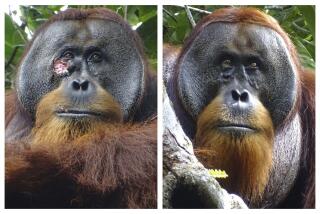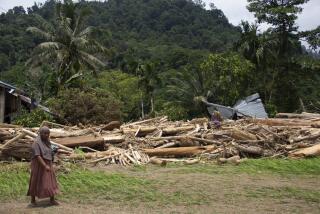Like orangutans? You can volunteer to help them at a ‘forest school’ in Indonesia
- Share via
KETAPANG, Indonesia — International Animal Rescue doesn’t just help macaques; it saves and rehabilitates a variety of animals, such as India’s dancing bears, migrating birds that are illegally shot down each year as they fly over Malta, and the impossibly cute slow loris, now in danger of extinction.
Protection of the critically threatened orangutan also is a major focus of the organization. This includes babies taken from their mothers and illegally sold as pets and, perhaps more significant, those abandoned due to deforestation by the oil palm industry, particularly in Kalimantan, the Indonesian part of the island of Borneo.
This is one of two places on the planet — the other is Sumatra — where orangutans live in the wild.
Hence this stop on my Indonesia tour: IAR’s Orangutan Rescue Center outside Ketapang, a small city on Kalimantan’s Pawan River delta and a 75-minute flight from Jakarta.
SIGN UP for the free In the Loop theme parks newsletter >>
The center was established in 2009 to provide a permanent facility for rescued orangutans. It includes a fully equipped clinic, quarantine capabilities and open enclosures around forested land to provide young orangutans a natural environment in which to learn necessary survival skills before being released.
It was a stifling early December afternoon, with the equatorial sun searing through the overcast sky, as a group of visitors from the U.S. Agency for International Development, the U.S. Embassy in Jakarta and I walked the grounds learning about the plight of these “people of the forest.”
I was part of this group because my spouse is a veterinarian, but IAR welcomes volunteers here for 28-day stays, for about $1,950 (food and lodging included). Activities include helping with new construction, raising produce used to feed the orangutans and maintaining the cages.
Days off can be spent visiting local beaches and exploring places such as Hutan Kota Park, with its wild proboscis and macaque monkeys.
“Orangutan” derives from the Malay words “orang,” which means person, and “utan,” a derivative of the term for forest. This makes sense, because they share 97% of our DNA.
As we entered a gated enclosure, we heard the warning squeaks of several youngsters scurrying up into the trees.
“These orangutans were removed from their mothers when they were small babies,” said veterinarian Karmele Llano Sanchez, IAR Indonesia’s program director.
“Normally, they’re taught what they should and shouldn’t eat, how to make a nest, how to avoid predators, everything. But these guys haven’t had that opportunity, so they need to learn these skills before we release them,” Sanchez said.
Hence, the forest school, where orangutans educate one another in the finer points of jungle life. Unfortunately, because of their relatively short window for learning, which usually lasts until age 7, some never graduate.
“We have rescue animals that have spent 15 years in captivity in a cage and have never seen a forest. It’s probably impossible to ever try to release them,” Sanchez said.
The center houses about 80 orangutans, though the number is constantly changing. The week before I arrived, six wild orangutans had been rescued from an oil palm plantation.
Just a couple of weeks before that, it was Hitachi, named for the Hitachi bulldozer that had been clearing land around the tree that housed his nest. “It was quite shocking,” said Sanchez, “because everything had been destroyed, and we saw this big male with cheek pads [meaning he was more than 20 years old] sleeping in the last standing tree. Luckily, the bulldozer operator decided not to bring the tree down, or Hitachi would’ve fallen and died.”
Ironically, that same bulldozer was used in his rescue. Though Hitachi was skinnier than any orangutan she’d seen rescued, he is now quite healthy. Sanchez released him in March in Gunung Palung National Park, north of Ketapang.
::
A swampy trek to look for orangutans in Borneo’s Pematang Gadung forest
Even a casual traveler will appreciate that the country has some of the world’s most pristine, ecologically diverse woodlands. This is why International Animal Rescue also works with organizations and institutions dedicated to ensuring their viability.
This includes Pematang Gadung, a community forest I visited in December on my last full day in Borneo. I was awakened by the 4:30 a.m. Muslim call to prayer, and within an hour was sitting in a pickup truck munching on breakfast from Indonesia’s answer to Dunkin’ Donuts.
After filling the tank, using a funnel at a roadside “gas station,” IAR veterinarian Karmele Llano Sanchez and I cruised through the outskirts of Ketapang, dodging potholes and the steady stream of mopeds.
We soon turned down a rutted dirt road interrupted by vast stretches of rice paddies rimmed with coconut palms.
Forty-five minutes later, we were in speedboats on the Sempuluh River, stopping occasionally to gape at macaques jumping from tree to tree. The river eventually narrowed, and we arrived at IAR’s dock, which doubles as a camp and the starting point for the organization’s biodiversity studies.
“We’re going to get wet up to our hips,” Sanchez said. I wasn’t expecting to get in the river, much less wade through it, for the entire hike. Somehow I’d misunderstood that we’d be searching for orangutans in a swamp forest.
But the black and red water was pleasantly cool, and the rhythmic sounds of sloshing mesmerized me. So too the far-off calls of a group of proboscis monkeys.
As for the orangutans, the closest we came to seeing some was spotting a few nests high above us and finding a tree with remnants of durian, their favorite fruit, at its base.
Yes, it would have been thrilling to see one of these amazing creatures in their natural environment, but I’m happy that at least for the moment, their home here is untouched.
More to Read
Sign up for The Wild
We’ll help you find the best places to hike, bike and run, as well as the perfect silent spots for meditation and yoga.
You may occasionally receive promotional content from the Los Angeles Times.






